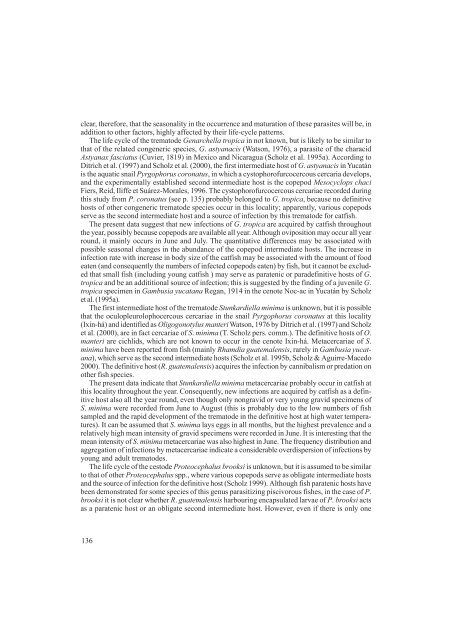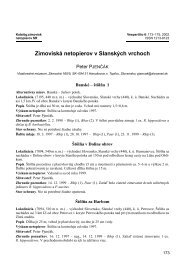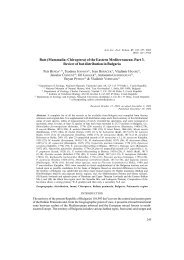Gyraulus parvus (Mollusca: Gastropoda) in the Czech Republic
Gyraulus parvus (Mollusca: Gastropoda) in the Czech Republic
Gyraulus parvus (Mollusca: Gastropoda) in the Czech Republic
- No tags were found...
You also want an ePaper? Increase the reach of your titles
YUMPU automatically turns print PDFs into web optimized ePapers that Google loves.
clear, <strong>the</strong>refore, that <strong>the</strong> seasonality <strong>in</strong> <strong>the</strong> occurrence and maturation of <strong>the</strong>se parasites will be, <strong>in</strong>addition to o<strong>the</strong>r factors, highly affected by <strong>the</strong>ir life-cycle patterns.The life cycle of <strong>the</strong> trematode Genarchella tropica <strong>in</strong> not known, but is likely to be similar tothat of <strong>the</strong> related congeneric species, G. astyanacis (Watson, 1976), a parasite of <strong>the</strong> characidAstyanax fasciatus (Cuvier, 1819) <strong>in</strong> Mexico and Nicaragua (Scholz et al. 1995a). Accord<strong>in</strong>g toDitrich et al. (1997) and Scholz et al. (2000), <strong>the</strong> first <strong>in</strong>termediate host of G. astyanacis <strong>in</strong> Yucatánis <strong>the</strong> aquatic snail Pyrgophorus coronatus, <strong>in</strong> which a cystophorofurcocercous cercaria develops,and <strong>the</strong> experimentally established second <strong>in</strong>termediate host is <strong>the</strong> copepod Mesocyclops chaciFiers, Reid, Iliffe et Suárez-Morales, 1996. The cystophorofurcocercous cercariae recorded dur<strong>in</strong>gthis study from P. coronatus (see p. 135) probably belonged to G. tropica, because no def<strong>in</strong>itivehosts of o<strong>the</strong>r congeneric trematode species occur <strong>in</strong> this locality; apparently, various copepodsserve as <strong>the</strong> second <strong>in</strong>termediate host and a source of <strong>in</strong>fection by this trematode for catfish.The present data suggest that new <strong>in</strong>fections of G. tropica are acquired by catfish throughout<strong>the</strong> year, possibly because copepods are available all year. Although oviposition may occur all yearround, it ma<strong>in</strong>ly occurs <strong>in</strong> June and July. The quantitative differences may be associated withpossible seasonal changes <strong>in</strong> <strong>the</strong> abundance of <strong>the</strong> copepod <strong>in</strong>termediate hosts. The <strong>in</strong>crease <strong>in</strong><strong>in</strong>fection rate with <strong>in</strong>crease <strong>in</strong> body size of <strong>the</strong> catfish may be associated with <strong>the</strong> amount of foodeaten (and consequently <strong>the</strong> numbers of <strong>in</strong>fected copepods eaten) by fish, but it cannot be excludedthat small fish (<strong>in</strong>clud<strong>in</strong>g young catfish ) may serve as paratenic or paradef<strong>in</strong>itive hosts of G.tropica and be an addititional source of <strong>in</strong>fection; this is suggested by <strong>the</strong> f<strong>in</strong>d<strong>in</strong>g of a juvenile G.tropica specimen <strong>in</strong> Gambusia yucatana Regan, 1914 <strong>in</strong> <strong>the</strong> cenote Noc-ac <strong>in</strong> Yucatán by Scholzet al. (1995a).The first <strong>in</strong>termediate host of <strong>the</strong> trematode Stunkardiella m<strong>in</strong>ima is unknown, but it is possiblethat <strong>the</strong> oculopleurolophocercous cercariae <strong>in</strong> <strong>the</strong> snail Pyrgophorus coronatus at this locality(Ix<strong>in</strong>-há) and identified as Oligogonotylus manteri Watson, 1976 by Ditrich et al. (1997) and Scholzet al. (2000), are <strong>in</strong> fact cercariae of S. m<strong>in</strong>ima (T. Scholz pers. comm.). The def<strong>in</strong>itive hosts of O.manteri are cichlids, which are not known to occur <strong>in</strong> <strong>the</strong> cenote Ix<strong>in</strong>-há. Metacercariae of S.m<strong>in</strong>ima have been reported from fish (ma<strong>in</strong>ly Rhamdia guatemalensis, rarely <strong>in</strong> Gambusia yucatana),which serve as <strong>the</strong> second <strong>in</strong>termediate hosts (Scholz et al. 1995b, Scholz & Aguirre-Macedo2000). The def<strong>in</strong>itive host (R. guatemalensis) acquires <strong>the</strong> <strong>in</strong>fection by cannibalism or predation ono<strong>the</strong>r fish species.The present data <strong>in</strong>dicate that Stunkardiella m<strong>in</strong>ima metacercariae probably occur <strong>in</strong> catfish atthis locality throughout <strong>the</strong> year. Consequently, new <strong>in</strong>fections are acquired by catfish as a def<strong>in</strong>itivehost also all <strong>the</strong> year round, even though only nongravid or very young gravid specimens ofS. m<strong>in</strong>ima were recorded from June to August (this is probably due to <strong>the</strong> low numbers of fishsampled and <strong>the</strong> rapid development of <strong>the</strong> trematode <strong>in</strong> <strong>the</strong> def<strong>in</strong>itive host at high water temperatures).It can be assumed that S. m<strong>in</strong>ima lays eggs <strong>in</strong> all months, but <strong>the</strong> highest prevalence and arelatively high mean <strong>in</strong>tensity of gravid specimens were recorded <strong>in</strong> June. It is <strong>in</strong>terest<strong>in</strong>g that <strong>the</strong>mean <strong>in</strong>tensity of S. m<strong>in</strong>ima metacercariae was also highest <strong>in</strong> June. The frequency distribution andaggregation of <strong>in</strong>fections by metacercariae <strong>in</strong>dicate a considerable overdispersion of <strong>in</strong>fections byyoung and adult trematodes.The life cycle of <strong>the</strong> cestode Proteocephalus brooksi is unknown, but it is assumed to be similarto that of o<strong>the</strong>r Proteocephalus spp., where various copepods serve as obligate <strong>in</strong>termediate hostsand <strong>the</strong> source of <strong>in</strong>fection for <strong>the</strong> def<strong>in</strong>itive host (Scholz 1999). Although fish paratenic hosts havebeen demonstrated for some species of this genus parasitiz<strong>in</strong>g piscivorous fishes, <strong>in</strong> <strong>the</strong> case of P.brooksi it is not clear whe<strong>the</strong>r R. guatemalensis harbour<strong>in</strong>g encapsulated larvae of P. brooksi actsas a paratenic host or an obligate second <strong>in</strong>termediate host. However, even if <strong>the</strong>re is only one136








